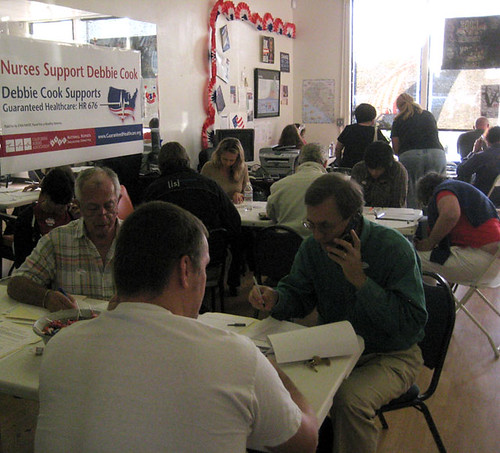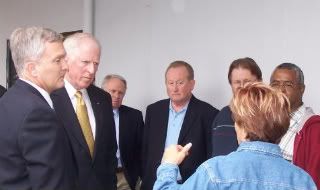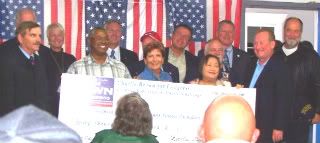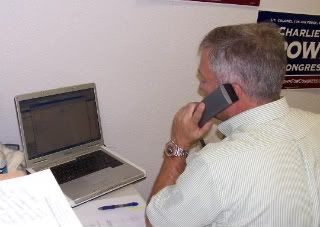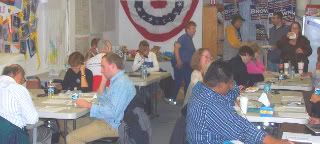(While they won’t replace good old-fashioned shoe leather, tools matter. – promoted by Brian Leubitz)
Consultants in California and everywhere would like us to believe that the money game is everything. But something seems to be changing. On November 3rd of this year, a loose coalition of progressive groups won a tremendous set of victories in a small California city despite getting outspent by a factor of more than 20. This could be what California democracy would look like if it was built on a person to person foundation. The following is a first-person account from Hillary Blackerby, Secretary of the local Democratic Party organization, who asked me to post it (full discolsure, this post says nice things about California VoterConnect):
The City of Santa Barbara on California’s Central Coast is one of those silly places that still has its city elections in November of odd years. Our city ballot this year consisted of a mayor’s seat, 3 city council seats and 4 ballot measures. Two of the five mayoral candidates were current sitting councilmembers with time left in their terms, so if one of them were to win the mayor’s seat, the 4th highest vote getter in the council race would get a 2 year term to finish out the mayor’s council term. There were thirteen candidates for city council.
Progressive organizations with ground forces that were activated for the campaign included…
…the Santa Barbara Democratic County Central Committee (county party central committees are the local organizations that together comprise the state party), the Democratic Service Club (which is a club chartered under the county committee), and a local social justice focused community based organization, PUEBLO (People United for Economic Justice Building Leadership through Organizing), that has strong roots in the Latino community. The Democratic organizations and PUEBLO share in Santa Barbara’s culture of locally-directed, person to person organizing, which has been growing stronger particularly due to large influxes of volunteers after the 2000 and 2002 elections, as well as by connecting with volunteers activated for Obama last year. The total campaign spending by the local Democratic Party was less than $30k.
The most important ballot measure was Measure B, which proposed a draconian building height limit of 40 feet in the downtown area, thereby diminishing the hope of a vibrant and sustainable downtown core where people could live near where they work, shop and play. This measure also threatened our ability to provide affordable and workforce housing, and would inevitably encourage sprawl into our ecologically sensitive surroundings, like the precious Gaviota coast. Our special kind of NIMBY (Not In My Backyard) here in Santa Barbara (both of Republican and Democratic stripes) was incredulous that anyone would oppose this measure. The political establishment in the town predicted that Measure B would be the defining issue of the campaign, and nearly all of the candidates lined up in favor of it or stayed neutral. The county Democratic Party allied itself with affordable housing advocates and environmentalists and took a strong “vote NO” position on Measure B.
Enter the opposition: We learned in late September that Texas Republican and billionaire developer and owner of First Texas Homes, Randall Van Wolfswinkel, was planning to spend hundreds of thousands of dollars on this race. Van Wolfswinkel had started a PAC based in Los Angeles called “Preserve Our Santa Barbara” (POSB) and had selected a conservative slate of 3 city council candidates and a mayoral candidate to support both through independent expenditure and direct donations to the council candidates. He also essentially singlehandedly funded the campaign for Yes on Measure B, and ended up spending over $700,000 on this race.
This was done through television, radio, web banner ads, newspaper ads, and a deluge of mail. In one 9 day period during the election, city voters received 10 pieces of mail from his PAC alone, most of them being hit pieces against 2 of the mayoral candidates (Helene Schneider and Steve Cushman) and 2 of the Democratic council candidates (Bendy White and incumbent Grant House). The tactics for negative campaigning POSB used focused on NIMBY baiting, including making the claim that skyscrapers would spring up on our city streets (our city charter already has a 60 foot/4 story limit.) They focused on race baiting about gang and youth violence, with pictures of graffiti on brick walls (definitely from istockphoto, not pictures in SB.) These problems have increased somewhat over the last few years, but largely due to cuts in services and the increasingly bleak and unequal state economy, a problem that further limiting affordable housing would hardly improve. POSB also railed against public employees and their supposedly bloated salaries and the misplaced priorities of the current mayor and council. The TV ads used the rhetoric of “they’re on our side” and admonished voters to “save our community.” We wondered: “From who exactly?” Santa Barbara is about 35% Latino and fairly segregated; the racial undertones and dogwhistles of these ads seemed clear to progressives.
This election was Santa Barbara’s first all mail-in ballot election, and we knew we’d have to evolve our GOTV tactics to think in terms of election month, not election day, even more than we had been already due to increasing numbers of permanent vote-by-mail voters. We started with voter roll data provided via California VoterConnect‘s VAN (VAN is the Voter Activation Network, the same software that the DNC and Obama for America deployed nationally in 2008), which we used to run lists for door to door contacts. Our data included vote history from the last statewide elections, as well as the local 2007 city council election, which helped us understand turnout the last time there were only city issues on the ballot. Our focus was on Democratic households, as Democrats enjoy a significant registration advantage in the City of Santa Barbara. Ballots arrived in mailboxes Monday and Tuesday October 5th and 6th. The weekends prior and following the ballot arrival days, the Democratic Party sent volunteers out to go door to door with labeled lit pieces with our party-endorsed candidates and voter information to about 15,000 targeted Dem households in the city.
We planned two early direct mail pieces to Democrats- one prior to the ballots arriving, and one in the first week of voting. In the first 3 weeks after ballots hit mailboxes, the rate of return into the city clerk’s office was abysmal. Republicans are a small percentage of the electorate, but they were voting in much higher percentages than Dems in those weeks. At one point we were seeing around 50% turnout from people over 65, while fewer than 200 registered voters under 25 had cast ballots. The turnout started to pick up in the last week before the election, with 1,100 to 1,500 ballots arriving daily. The city registrar was releasing updated lists of voters whose ballots had been received, so when it was time for GOTV weekend, we had uploaded the most recent list of people who had already voted (the VAN makes this easy), and purged them from our list of targeted voters.
For the knocking and talking phase of the field operation, we cut precinct-based walk lists with the VAN’s nifty turf cutting/mapping tool, dividing precincts up into manageable turfs for volunteers (about 3 or 4 turfs per precinct, with approximately 100 doors per turf). We knocked and talked every Saturday and Sunday beginning on August 30th on through the election. These turfs would later shrink to a 50-60 door size by GOTV weekend as some of our targeted voters had mailed in their ballots. We augmented this door to door effort with aggressive phonebanking with the stellar and affordable Callfire autodialer system. Our phonebanking operation consisted of calling Democratic voters beginning in the last week of August for 3 days a week (Tuesday-Thursday), with about a dozen volunteers calling with the Callfire system from their homes at different times of the week.
Not everything went smoothly, however. The campaigns of the endorsed Democrats (all sharing the same consultant and staff) did not do a single phonebank, and they were without access to data for the final month of the campaign due to their inability to fill out the small amount of paperwork required by the vendor. The consultant also wouldn’t allow the campaigns’ paid field staff or recruited volunteers to walk the party full slate literature (even though all their candidates were the same) because it contained a No on Measure B position, which the conventional wisdom (as propagated by the consultant) said would hurt his candidates. This led to the needless and stubborn duplication of efforts, reinvention of a few wheels, and in certain instances, even the subversion of the wishes of one of the candidates who personally opposed Measure B.
This issue raises serious questions about the role of consultants and campaigns in areas with strong democratic progressive infrastructure. We need better mechanisms to prevent unscrupulous consultants from taking advantage of volunteer time and energy that organizers have built up over years of work, and better ways to hold candidates accountable. One clear path is to strengthen the candidate pipeline from the grassroots upwards. Experience has shown that candidates with origins in the grassroots will be less likely to ignore or turn on the grassroots as they are elected to local and higher office.
The final weekend GOTV phone operation consisted of calling some 3,000 identified supporters using Callfire, as well as from some paper lists due to the small number of computers and large numbers of volunteers. The two main election day field operations were run by the county Democratic Party and by PUEBLO, both using lists from the VAN. There were 7 ballot drop off locations throughout the city. This is a drastic reduction from the number of polling places that are normally open around the city when the election isn’t all mail-in ballots. They were open on Saturday October 31st, from 8am to 5pm, and again on Tuesday November 3rd, from 7am to 8pm.
When volunteers spoke to voters on the phone or at their doors, many assumed they could go to their usual polling place- not so. They appreciated finding out where they could go drop off their ballots, or if they had lost or never received the ballot by mail, that they could go to the drop off site and vote on a provisional ballot. Many people never received their ballots because either they had registered before the registration deadline but after the city had sent the list to the mailhouse to send the ballots to (yes they really did that). There were also reported instances of people in apartment and condo complexes seeing a USPS mail bin full of all the ballots for the entire complex sitting beneath the bank of mailboxes, much like the 3rd class junkmail that we get every week.
Election day volunteers did an early morning lit drop with bilingual info for voters about where to drop off their ballots, and with a list of our Democratic Party endorsed candidates and ballot measure positions. They later rewalked the turf in the middle of the day, hitting the homes of people who still had not voted as of the last pass. Volunteers were out in the neighborhoods until the polls closed at 8pm, and phonebankers called through the turfs pulling folks out in the last 2 hours and telling them where they can drop their ballots.
By midday Monday November 2nd, turnout was at 37%, which was the total turnout for the 2007 city elections. By the end of Tuesday November 3rd, total turnout was 49.5%. The GOTV field efforts by the progressive forces pushed turnout in one day up by over 12 percent. In a city of about 90,000 people, where there are 46,718 registered voters, there were 23,167 ballots cast in an off-cycle election year. We beat back the assault on social justice that was Measure B, won the mayor’s race and elected two of our three Democratic Party endorsed city council candidates. Dozens of volunteers on election day made the difference by going back again and again to the folks who still hadn’t voted.
Perhaps the most dramatic shift from pre-election day results to November 3rd results was the comparative result for No on Measure B, which received 62% of the Election Day votes, up from 51% of the pre-Election Day votes. The Texas billionaire spent more than $700,000. The Democratic Party spent less than $30,000. Nothing beats a solid field campaign: not even getting outspent by more than 23 to 1.
Last week, every city voter received another glossy mailer in their boxes. It was Randall Van Wolfswinkel thanking them, and letting us know that he will indeed be back. And when he comes back, we will be ready with our clipboards, volunteers, and shoe leather…and our databases.
Hillary Blackerby is the secretary of the Santa Barbara County Democratic Party Central Committee.


